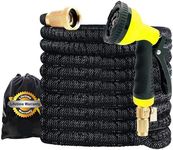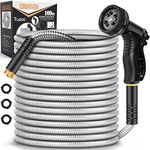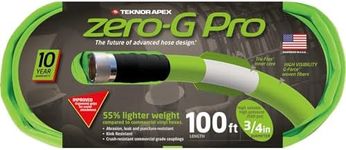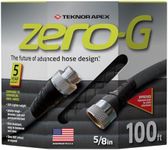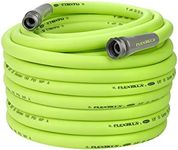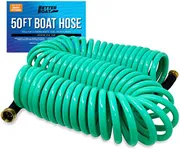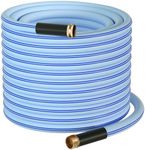Buying Guide for the Best 100 Foot Garden Hose
Choosing the right garden hose can make your gardening tasks much easier and more efficient. When selecting a 100-foot garden hose, there are several key specifications to consider to ensure you get the best fit for your needs. Understanding these specs will help you make an informed decision and find a hose that meets your requirements for durability, ease of use, and performance.MaterialThe material of the garden hose is crucial because it affects the hose's durability, flexibility, and weight. Common materials include rubber, vinyl, and polyurethane. Rubber hoses are very durable and can withstand high pressure and extreme temperatures, but they are heavier. Vinyl hoses are lighter and more affordable but less durable. Polyurethane hoses offer a good balance of durability and weight. Choose a material based on your need for durability versus ease of handling.
DiameterThe diameter of the hose determines the flow rate of water. Common diameters are 1/2 inch, 5/8 inch, and 3/4 inch. A 1/2 inch diameter hose is suitable for light watering tasks and is easier to handle. A 5/8 inch diameter hose is the most versatile, providing a good balance between water flow and ease of use. A 3/4 inch diameter hose offers the highest flow rate, ideal for heavy-duty watering tasks but can be more cumbersome to handle. Choose the diameter based on the volume of water you need and the ease of handling you prefer.
FlexibilityFlexibility is important for maneuvering the hose around your garden without kinking. Hoses made from materials like rubber and polyurethane tend to be more flexible than vinyl hoses. However, more flexible hoses can be prone to kinking if not properly managed. Consider how often you will be moving the hose around and whether you need a hose that can easily navigate tight spaces.
CouplingsCouplings are the connectors at the ends of the hose that attach to the water source and nozzle. They can be made from plastic, brass, or aluminum. Brass couplings are the most durable and resistant to corrosion, making them a good choice for long-term use. Plastic couplings are lighter and less expensive but can break more easily. Aluminum couplings offer a balance between durability and weight. Choose couplings based on your need for durability and ease of use.
Burst PressureBurst pressure indicates the maximum pressure the hose can withstand before bursting. It is measured in pounds per square inch (PSI). For general gardening tasks, a hose with a burst pressure of around 300 PSI is usually sufficient. For more demanding tasks, such as using a pressure washer, you may need a hose with a higher burst pressure. Consider the water pressure in your area and the types of tasks you will be performing to choose the appropriate burst pressure.
WeightThe weight of the hose affects how easy it is to handle and maneuver. Heavier hoses, such as those made from rubber, are more durable but can be more difficult to move around. Lighter hoses, such as those made from vinyl or polyurethane, are easier to handle but may not be as durable. Consider your physical strength and how often you will be moving the hose around your garden to choose the right weight.
Weather ResistanceWeather resistance refers to the hose's ability to withstand various weather conditions, such as extreme heat, cold, and UV exposure. Rubber hoses are generally more weather-resistant than vinyl hoses. If you live in an area with harsh weather conditions, choose a hose that is specifically designed to withstand those conditions to ensure longevity and performance.

